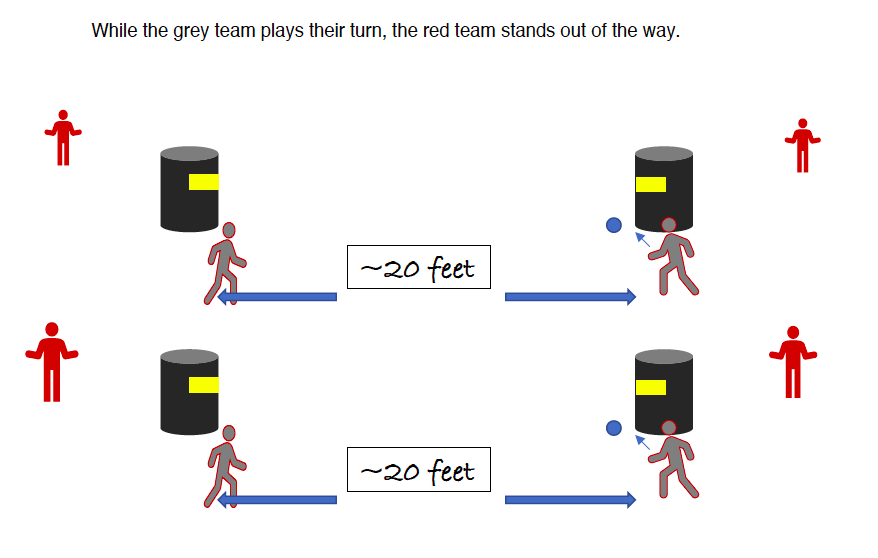SlamJam
Lesson Topic:
Game Play, Lead up To KanJam (used with permission)
Lesson Description:
This lesson teaches the game of "SlamJam", a modified version of KanJam. Using modified equipment allows students to focus on the rules of play, and prepares them to apply rules and add more challenging frisbees in later lessons.
Learning Goals/Outcomes:
Students will apply strategy to types of throws they take in order to correctly reach 21 points.
Students will use throwing and deflecting techniques to be successful.
Students will learn the rules of KanJam and apply the rules to a game situation.
Students will apply teamwork and cooperation as they work with many different partners during a tournament.
Nebraska Standards:
PE.HS.14.1.a Performs and/or refines activity-specific movement skills in a variety of lifetime activities.
PE.HS.14.1.b Demonstrates competent skill performance of basic and advanced skills by scoring and preventing scoring as an individual/team within authentic settings of lifetime game activities.
PE.HS.14.2.c Applies
appropriate strategies in a variety of lifetime activities.
PE.HS.14.2.e Applies the rules and understanding of the terminology in a variety of lifetime activities.
PE.HS.14.2.f Communicates with teammates using proper terminology in a variety of lifetime activities.
PE.HS.14.3.c Exhibits
etiquette, respect for others, and teamwork while engaging in lifetime
activities.
PE.HS.14.3.e Exhibits good sportsmanship and plays within the rules in a variety of lifetime activities.
Teacher Planning:
Equipment/Materials Needed:
2 KanJam goals for each group of 4 students
1 gator skin ball per group of 4
Signs posted with point explanations.
Time Required for Lesson:
30 - 45 minutes
Diagram/Setup:
Officially, KanJam is played at a distance of 50 feet. For the modified game of SlamJam, using a foam ball, I place the targets 20 feet apart to start, and increase as skill and confidence allow.

KanJam Set up diagram
Technology Use:
_____ YES __x___NO
Instructional Plan:
Anticipatory Set/Pre-Activity:
Video: How to Play KanJam
Benefits/Explanation/Real-World Connection:
Students are beginning a yard games unit. They will be playing KanJam, but we have found if we first play with foam balls, their confidence increases. They focus on how to play without being frustrated by inaccurate frisbee throws and pain of deflecting the hard plastic. After a day with foam balls, students are ready to take the intensity up and use real frisbees. Then, they have learned an activity that can be played outdoors with little set up and small groups.
Activities (i.e. instructions, warm-up, lesson, cool-down):
Warm up:
Students practice self tossing balls to the goals (KanJam).
Instructions:
Basic rules, Two teams of
two play against each other.
- Teams stand on opposite sides of room, one teammate by each goal.
- Teammates will each have a turn at being the thrower, and deflector.
- Team that throws first has one player throw, and the other player attempt to deflect ball to goal. The deflector becomes the thrower and attempts to score with their partner becoming the deflector.
- Once both players have taken a turn, the other team steps in and attempts their throws.
- The opposing team may not play defense in any way.
- The thrower should throw from behind goal. Deflector can stand anywhere.
- Deflector may not catch or carry the disc, they may use one or two hands.
- Ball must hit or go in goal without hitting the floor.
Scoring:
1 PT : DINGER: Redirected hit by deflector, hitting any part of the goal. Cannot hit floor first.
2 PT: DUECE: Direct hit by thrower, hitting any part of the goal unassisted by partner.
3 PT: BUCKET: Redirected hit by deflector, landing inside the goal.
INSTANT WIN: Direct entry – thrown by thrower, unassisted by partner. May enter mouth OR top of goal.
GAME 21 POINTS – Must hit 21 points exact. If you go over 21 points, score returns to where it was before
toss.
Activity:
Use a quick technique to pair students up. Explain rules and begin play. Have students see which team can get to 21 first.
Stop after 5 minutes and address the class. What's working? What questions have arisen? Continue play.
Teacher circulate and assist with misunderstandings.
Closure:
Summative assessment: Plickers question : If I have 19 points, what type of shot would I want to take to get to 21?
Assessment :
Formative assessments that can be performed during game play.
- Assess deflector on ability to move to the ball, contact and direct the ball
- Assess thrower on skill of ball placement to best work with deflector
- Assess strategy of scoring and not going over 21
- Rubric on Team Play
Summative assessment: Plickers question : If I have 19 points, what type of shot would I want to take to get to 21?
A. Dinger B. Duece C. Bucket D. Ringer
Supplemental Information:
Modifications:
For younger students, if keeping track of score make sure to have a clothspin scorecard or other device.
Safety Precautions:
Space goals appropriate distance so balls being thrown by teams stay in their own court.
Comments (adaptations for various grades/ages, teaching styles, etc.)
Set up: Post points on goals, or at cones at each playing station.
Adaptations:
- Move goals closer or farther away.
- Use laundry baskets or boxes instead of KanJam
- During game play, call switch and have teams intermix. Then have the NEW team move to a new goal where they will play a new team. Continue with switch and move.
- Play king of the court tournament style; when any team at any court wins (instant or 21) all games stop, winner or team with most points moving on. Can add the partner switch from above to this tournament. So each time, they move up or down a court. Then, stand at the same goal as their partner. They will form a new team with a player standing across at the other goal.
- Many other versions can be found at KanJam.com
